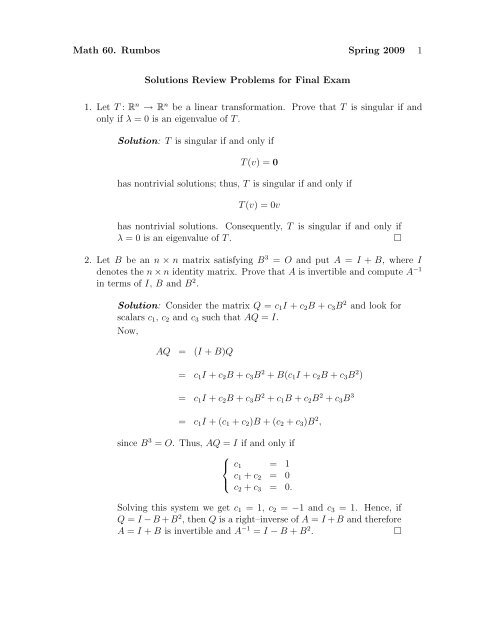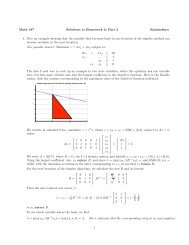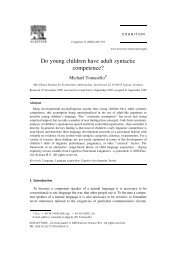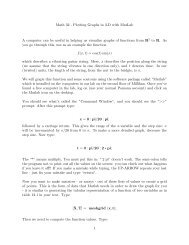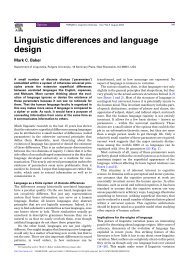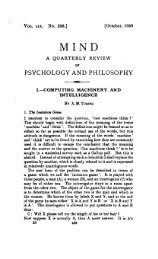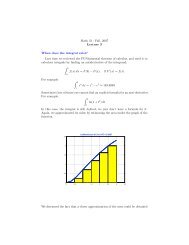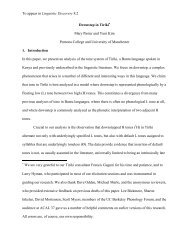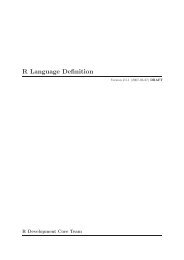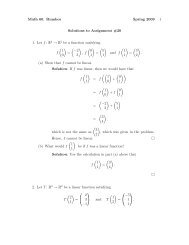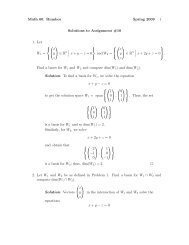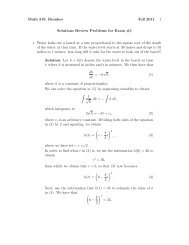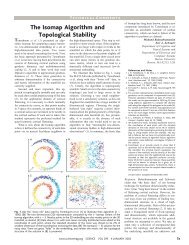Math 60. Rumbos Spring 2009 1 Solutions Review Problems for ...
Math 60. Rumbos Spring 2009 1 Solutions Review Problems for ...
Math 60. Rumbos Spring 2009 1 Solutions Review Problems for ...
- No tags were found...
You also want an ePaper? Increase the reach of your titles
YUMPU automatically turns print PDFs into web optimized ePapers that Google loves.
<strong>Math</strong> <strong>60.</strong> <strong>Rumbos</strong> <strong>Spring</strong> <strong>2009</strong> 1<strong>Solutions</strong> <strong>Review</strong> <strong>Problems</strong> <strong>for</strong> Final Exam1. Let T : R n → R n be a linear trans<strong>for</strong>mation. Prove that T is singular if andonly if λ = 0 is an eigenvalue of T .Solution: T is singular if and only ifT (v) = 0has nontrivial solutions; thus, T is singular if and only ifT (v) = 0vhas nontrivial solutions. Consequently, T is singular if and only ifλ = 0 is an eigenvalue of T .□2. Let B be an n × n matrix satisfying B 3 = O and put A = I + B, where Idenotes the n × n identity matrix. Prove that A is invertible and compute A −1in terms of I, B and B 2 .Solution: Consider the matrix Q = c 1 I + c 2 B + c 3 B 2 and look <strong>for</strong>scalars c 1 , c 2 and c 3 such that AQ = I.Now,AQ = (I + B)Q= c 1 I + c 2 B + c 3 B 2 + B(c 1 I + c 2 B + c 3 B 2 )= c 1 I + c 2 B + c 3 B 2 + c 1 B + c 2 B 2 + c 3 B 3= c 1 I + (c 1 + c 2 )B + (c 2 + c 3 )B 2 ,since B 3 = O. Thus, AQ = I if and only if⎧⎨ c 1 = 1c 1 + c 2 = 0⎩c 2 + c 3 = 0.Solving this system we get c 1 = 1, c 2 = −1 and c 3 = 1. Hence, ifQ = I − B + B 2 , then Q is a right–inverse of A = I + B and there<strong>for</strong>eA = I + B is invertible and A −1 = I − B + B 2 .□
<strong>Math</strong> <strong>60.</strong> <strong>Rumbos</strong> <strong>Spring</strong> <strong>2009</strong> 23. Let A =( )1/2 1/3.1/2 2/3(a) Find a basis <strong>for</strong> R 2 made up of eigenvectors of A.Solution: First, we look <strong>for</strong> values of λ such that the system(A − λI)v = 0 (1)has nontrivial solutions in R 2 . This is the case if and only ifdet(A − λI) = 0, which occurs if and only ifλ 2 − 7 6 λ + 1 6 = 0,or((λ − 1) λ − 1 )= 0.6We then get thatλ 1 = 1 6and λ 2 = 1are eigenvalues of A.To find an eigenvector corresponding to the eigenvalue λ 1 , wesolve the system in (1) <strong>for</strong> λ = λ 1 . In this case, the system canbe reduced to the equationx 1 + x 2 = 0,which has solutions(x1x 2)( ) 1= t ,−1where t is arbitrary. We can there<strong>for</strong>e take( ) 1v 1 =−1as an eigenvector corresponding to λ = 1 6 .Similar calculations <strong>for</strong> λ = λ 2 = 1 lead to the equation3x 1 − 2x 2 = 0,
<strong>Math</strong> <strong>60.</strong> <strong>Rumbos</strong> <strong>Spring</strong> <strong>2009</strong> 3which has solutions(x1x 2)( ) 2= t ,3where t is arbitrary. Thus, in this case, we obtain the eigenvector( ) 2v 2 = .3Since v 1 and v 2 are linearly independent, the constitute a basis <strong>for</strong>R 2 because dim(R 2 ) = 2.□(b) Let Q be the 2 × 2 matrix Q = [ v 1 v 2 ], where {v 1 , v 2 } is the basis ofeigenvectors found in (a) above. Verify that Q is invertible and computeQ −1 AQ. What do you discover?( ) 1 2Solution: Q =, so that det(Q) = 3 + 2 = 5 ≠ 0.−1 3Hence Q is invertible andQ −1 = 1 ( ) 3 −2.5 1 1Next, computeQ −1 AQ = 1 5= 1 5= 1 5==( 3 −21 1( 3 −21 1( ) 5/6 00 5( ) 1/6 00 1( )λ1 0.0 λ 2) ( ) ( )1/2 1/3 1 21/2 2/3 −1 3) ( 1/6) 2−1/6 3Thus, Q −1 AQ is a diagonal matrix with the eigenvalues as entriesalong the main diagonal.□
<strong>Math</strong> <strong>60.</strong> <strong>Rumbos</strong> <strong>Spring</strong> <strong>2009</strong> 4(c) Use the result in part (b) above to find a <strong>for</strong>mula <strong>for</strong> <strong>for</strong> computing A k <strong>for</strong>every positive integer k. Can you say anything about lim A k ?k→∞( )λ1 0Solution: Let D denote the matrix. Then, from0 λ 2part (b) in this problem,Q −1 AQ = D.Multiplying this equation by Q on the left and Q −1 on the right,we obtain thatA = QDQ −1 .It then follows thatA 2 = (QDQ −1 )(QDQ −1 )= QD(Q −1 Q)DQ −1= QDIDQ −1= QD 2 Q −1 .We may now proceed by induction on k to show thatA k = QD k Q −1 <strong>for</strong> all k = 1, 2, 3, . . .In fact, once we have established thatwe computeA k−1 = QD k−1 Q −1 ,A k = AA k−1= (QDQ −1 )(QD k−1 Q −1 )= QD(Q −1 Q)D k−1 Q −1= QDID k−1 Q −1= QD k Q −1 .
<strong>Math</strong> <strong>60.</strong> <strong>Rumbos</strong> <strong>Spring</strong> <strong>2009</strong> 5Thus, we may compute A k as followsA k = QD k Q −1== 1 5= 1 5= 1 5= 1 5Observe that, as k → ∞,( ) ( ) k ( )1 2 λ1 0 1 3 −2−1 3 0 λ 2 5 1 1( ) ( ) ( )1 2 λk1 0 3 −2−1 3 0 λ k 2 1 1( ) ( ) ( )1 2 1/6k0 3 −2−1 3 0 1 1 1( ) ( 1 2 3/6k−2/6 k−1 3 1 1( (3/6 k ) + 2 −(2/6 k ) + 2−(3/6 k ) + 3 (2/6 k ) + 3A k →( )2/5 2/5.3/5 3/54. Let A be an m × n matrix and b ∈ R m . Prove that if Ax = b has a solution xin R n , then 〈b, v〉 = 0 <strong>for</strong> every v is the null space of A T .Solution: Let x be a solution of Ax = b and v ∈ N A T . Then,A T v = 0 and〈b, v〉 = 〈Ax, v〉= (Ax) T v= x T A T v= x T 0= 0.)).□□
<strong>Math</strong> <strong>60.</strong> <strong>Rumbos</strong> <strong>Spring</strong> <strong>2009</strong> 65. Let A be an m × n matrix. Prove that if A T is nonsingular, then Ax = b has asolution x in R n <strong>for</strong> every b ∈ R n .Solution: If A T is nonsingular, then the null–space, N A T , is thetrivial subspace, {0}, of R m . Consequently, dim(N A T ) = 0. Thus,by the Dimension Theorem <strong>for</strong> Matrices, the rank of A T is m, sinceA T ∈ M(n, m). Thus, since the rank of A T is the same as the rankof A, by the equality of the column and row ranks, it follows thatA ∈ M(m, n) has rank m. In other words, the dimension of thecolumn space of A is m. Thus, since the column space of A, C A , is asubspace of R m , it follows thatC A = R m .There<strong>for</strong>e, if A = [ v 1 v 2 · · · v n ], where v 1 , v 2 , . . . , v n are thecolumns of A , then <strong>for</strong> any b ∈ R m , there exist scalars c 1 , c 2 , . . . , c nsuch thatc 1 v 1 + c 2 v 2 + · · · + c n v n = b,orwhich implies that the system⎛ ⎞c 1c 2[ v 1 v 2 · · · v n ] ⎜ ⎟⎝ . ⎠ = b,c nAx = bhas a solution.□6. Let T : R n → R n denote a linear trans<strong>for</strong>mation. Prove that if λ is an eigenvalueof T , then λ k is an eigenvalue of T k <strong>for</strong> every positive integer k. If µ is aneigenvalue of T k , is µ 1/k always and eigenvalue of T ?Solution: Let λ be an eigenvalue of T : R n → R n . Then, there existsa nonzero vector, v, in R n such thatT (v) = λv.Applying the trans<strong>for</strong>mation, T , on both sides and using the fact thatT is linear and that v is an eigenvector corresponding to λ, we obtainthatT 2 (v) = T (λv) = λT (v) = λλv = λ 2 v,
<strong>Math</strong> <strong>60.</strong> <strong>Rumbos</strong> <strong>Spring</strong> <strong>2009</strong> 7so that, since v ≠ 0, λ 2 is an eigenvalue <strong>for</strong> T 2 .We may now proceed by induction on k to show thatλ k , <strong>for</strong> all k = 1, 2, 3, . . . ,is an eigenvalue of T k . To do this, assume we have established thatλ k−1 is an eigenvalue of T k−1 and that v is an eigenvector <strong>for</strong> T correspondingto the eigenvalue λ, so that v is also an eigenvector of T k−1corresponding to λ k−1 . We then have thatT k−1 (v) = λ k−1 v.Thus, applying the trans<strong>for</strong>mation, T , on both sides and using thefact that T is linear and that v is an eigenvector corresponding to λ,we obtain thatT k (v) = T (T k−1 v) = T (λ k−1 v) = λ k−1 T (v) = λ k−1 λv = λ k v,so that, since v ≠ 0, λ k is an eigenvalue <strong>for</strong> T k .Next, consider the function T : R 2 → R 2 given by rotation in thecounterclockwise sense by 90 ◦ or π/2 radians; that is,( ) ( ) ( ) ( )x 0 −1 x xT =<strong>for</strong> all ∈ R 2 .y 1 0 yyThen, T 2 : R 2 → R 2 is given by( ) ( ) ( )x −1 0 xT 2 =y 0 −1 y<strong>for</strong> all( xy)∈ R 2 ,which has µ = −1 as the only eigenvalue. Observe that T has no realeigenvalues, so µ 1/2 cannot be a (real) eigenvalue of T .□7. Let E = {e 1 , e 2 } denote the standard basis in R 2 , and let f : R 2 → R 2 be alinear function satisfying: f(e 1 ) = e 1 + e 2 and f(e 2 ) = 2e 1 − e 2 .Give the matrix representation <strong>for</strong> f and f ◦ f relative to E.Solution: Observe that( ) 1f(e 1 ) =1and f(e 2 ) =( ) 2.−1
<strong>Math</strong> <strong>60.</strong> <strong>Rumbos</strong> <strong>Spring</strong> <strong>2009</strong> 8It then follows that the matrix representation <strong>for</strong> f relative to E is( ) 1 2M f =.1 −1The matrix representation of f ◦ f is the product M f M f , or( ) ( ) ( )1 2 1 2 3 0M f◦f ==.1 −1 1 −1 0 38. A function f : R 2 → R 2 is defined as follows: Each vector v ∈ R 2 is reflectedacross the y–axis, and then doubled in length to yield f(v).Verify that f is linear and determine the matrix representation, M f , <strong>for</strong> frelative to the standard basis in R 2 .Solution: The function f is the composition of the reflection R: R 2 →R 2 given by( ) ( ) ( ) ( )x −1 0 x xR =, <strong>for</strong> all ∈ R 2 ,y 0 1 yyand the function T : R 2 → R 2 given by T (w) = 2w <strong>for</strong> all w ∈ R 2 or,in matrix <strong>for</strong>m,( ) ( ) ( ) ( )x 2 0 x xT =, <strong>for</strong> all ∈ R 2 .y 0 2 yyNote that both R and T are linear since they are both defined interms of multiplication by matrix. It then follows that f = T ◦ Ris linear and its matrix representation, M f , relative to the standardbasis in R 2 is( ) ( ) ( )2 0 −1 0 −2 0M f = M T M R ==0 2 0 1 0 29. Find a 2 × 2 matrix A such that the function T : R 2 → R 2 given by T (v) = Avmaps the coordinates of any vector, {( relative ) ( to the)}standard basis in R 2 , to its1 1coordinates relative the basis B = , .1 −1□□
<strong>Math</strong> <strong>60.</strong> <strong>Rumbos</strong> <strong>Spring</strong> <strong>2009</strong> 9Solution: Denote the vectors in B by v 1 and v 2 , respectively, so that( )( )1 1v 1 = and v1 2 = .−1We want the function T to satisfyT (v) = [v] B<strong>for</strong> every v ∈ R 2 given in terms of the standard basis in R 2 . We wantT to be linear, so that all we need to know about T is what it doesto the standard basis; that is, we need to know T (e 1 ) and T (e 2 ). Tofind out what T (e 1 ) is, we need to find scalars c 1 and c 2 such thatc 1 v 1 + c 2 v 2 = e 1. That is, we need to solve the system( ) ( )1 1 c1= e1 −1 c 1 ,2which we can solve by multiplying by the inverse of the matrix on theleft: ( )c1= 1 ( ) ( )−1 −1 1/2ec 2 −2 −1 1 1 = ,1/2so thatSimilarly,It then follows thatT (e 1 ) =T (e 2 ) =A =( ) 1/2.1/2( ) 1/2.−1/2( )1/2 1/2.1/2 −1/2□


